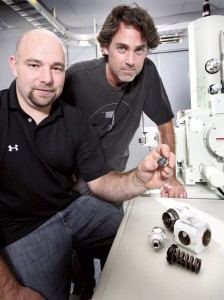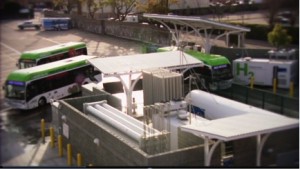Hydrogen experts at Sandia/California were tapped for their technical expertise through a first-ever contract with the state of California to investigate a May 4 hydrogen release at the Bay Area’s Alameda-Contra Costa Transit District (AC Transit) hydrogen fueling station in Emeryville, CA.
Based on the outcome of that investigation, on July 25, AC Transit’s board of directors unanimously agreed to adopt the Sandia researchers’ recommendations and take steps to re-open the station, which had been closed since the incident.
Sandia was asked by California’s Air Resources Board (ARB) and by DOE’s Office of Energy Efficiency and Renewable Energy (EERE) Fuel Cell Technologies program to lead the investigation into the hydrogen release incident. Although incident investigations are routine, with more than 5,000 gasoline-related incidents at gas stations per year, each of the handful of hydrogen-related incidents is taken extremely seriously to better understand the causes, implement lessons learned, and communicate best practices.
In their 33-page report, Investigation of the Hydrogen Release Incident at the AC Transit Emeryville Facility, Sandia researchers Aaron Harris and Chris San Marchi concluded that an internal component of a pressure relief valve used in the facility’s fueling station failed, and that the material of construction of the valve component, type 440-C martensitic stainless steel, was a poor choice for hydrogen service.
Harris and San Marchi say that they likely could not have successfully completed the investigation without the support of the lab’s machine shop and energy nanomaterials group. Together, those departments provided turn machining, microscopy, and metallurgic analysis that were vital to the project’s success.
“The fact that we were able to transition capabilities commonly used for scientific research to perform a high-visibility investigation in such a short time speaks to the cooperative culture and technical strength of Sandia,” says Harris.
With its hydrogen program, Sandia leverages long-established capabilities in understanding unintended hydrogen releases, storage systems, and materials compatibility in hydrogen and the application of these capabilities to support the development of safety, codes, and standards associated with the commercial use of hydrogen as a transportation fuel.
Sandia’s materials scientists, publishers of the Technical Reference for Hydrogen Compatibility of Materials, recommended that AC Transit replace pressure relief valves with devices specifically designed for hydrogen service. They also recommended a system-wide analysis of the materials for devices used at the station to ensure that designs account for material compatibility.
Sandia’s researchers note that manufacturers often offer similar components in hydrogen-compatible materials, such as type 316 austenitic stainless steel. Materials compatibility, Sandia researchers wrote, is only one of many parameters that design engineers must consider for hydrogen applications.
The Emeryville site is considered to be an essential component of California’s hydrogen fueling infrastructure and is part of ARB’s Zero Emission Bus (“ZBus”) program. The station is significant in that it offers both public automotive and AC Transit bus fueling capabilities.
While the failed component within the valve was found by Sandia to be the root cause of the accident, the safety features of the hydrogen station functioned properly, venting hydrogen overhead without causing harm. Multiple factors contributed to an unnecessary escalation of the event, Sandia analysts concluded, including the lack of timely communication regarding the status of the fueling system as well as the design approach for safety systems. A fire at the site, Sandia researchers say, resulted in relatively minor damage to the station canopy. There were no injuries.
Daniel Dedrick, the manager of Sandia’s hydrogen energy program, says the lab was able to quickly and effectively provide leadership and expertise in response to this event due to the established programs, capabilities, and partnerships that have been assembled with the investment of the Safety, Codes, and Standards program in the DOE EERE’s Office of Fuel Cell Technologies.
Looking toward the future, Daniel says Sandia is now working closely with ARB and with the California Fuel Cell Partnership to develop assessment tools to prevent future accidents and implement lessons learned from the Emeryville incident. Learning from these initial hydrogen refueling stations, he says, is critical for the continued successful deployment of hydrogen infrastructure in the US and around the world.
“Many tools are available that can help stakeholders plan for and prevent these kinds of events from happening,” says Dedrick. “We will continue to work with the state and the various stakeholders and jurisdictions to learn from the AC Transit incident and develop and implement tools to reduce the possibility of such accidents from happening in the future.”
The state, through energy initiatives such as the AB118 – Alternative and Renewable Fuel and Vehicle Technology Program, has supported the construction of hydrogen stations in northern and southern California, with more planned in the future.
Credit: Mike Janes

